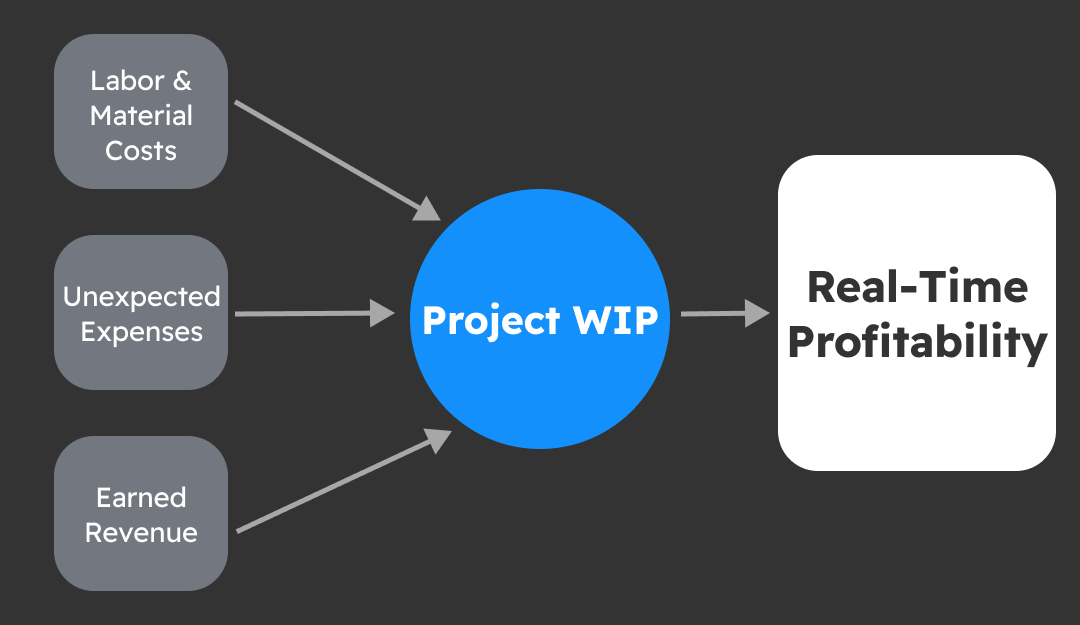For most construction companies, the name of the game in construction is profitability. Many construction companies sell millions every year, yet business owners often stay allow big-time profits to slip through the cracks. When used properly, a Work in Progress (WIP) report is a key part of job costing for maximizing profits and bringing in real net revenue for any construction company.
In this article we will answer these 4 questions, helping you understand WIP reports and maximize profitability on every project. Let’s get started!
Understanding WIP
- What is WIP?
- How is WIP calculated?
- What are the benefits of using a WIP report?
- How do I create a WIP report & track profitability on jobs?
1 – What is WIP?
A Project WIP (Work in Progress) Report, also known as Accrued Income Report, displays an up-to-date list of financial information for all active projects such as estimated and actual cost, the percent complete, and the estimated, earned, and actual revenue.
WIP Reports traditionally compare in real-time your estimated costs vs your actual costs, and give you an understanding of projected profit based on the work that has been completed (earned revenue). When using a WIP report, at any time in a project, you can see if a job is on pace for expected profit margins.
2 – How is WIP calculated?
A WIP report starts by creating a detailed estimate of your project. Factoring in material, labor, and equipment costs is crucial to having a project set up for success. After company hard costs have been calculated, markups and margins must be added. Before any job starts you should be able to answer “What does this cost” and “How much will I make”. Once you have these figures calculated, you can calculate WIP.
Once you have an estimated budget and profit margin, a WIP report allows you to track expenses against your actuals, and mark costs as complete to understand what additional expenses are upcoming on a job.
As you complete the scope of work and purchase materials, a WIP report will generate a few important metrics: “Income WIP” and “Projected Profit”.
Income WIP: Income WIP is income from work that has been completed but not yet invoiced for, or what your customer owes you for the work you have done. This is calculated by subtracting the amount that has been invoiced from the earned income.
Projected Profit: Projected profit is the net revenue that is expected to be earned on a project. This is calculated by subtracting the estimated cost of the project from the total price for the customer. For example, If I have $20,000 of direct costs on a $50,000 bathroom remodel project, my projected profit is $30,000.
3 – What are the benefits of using a WIP Report?
Compared with other reporting methods, WIP reports allow for real-time job costing. This allows you to be proactive instead of reactive when managing your job budgets. Instead of getting to the end of a job and realizing the extra day of labor, or unexpected material cost increase led to an unprofitable project, or a job that didn’t hit expected profit margins, you can use the WIP data to make actionable changes such as change orders or adjustments to timelines to help avoid profit loss.
A bathroom remodeling company I met with recently told me, “I often don’t know how much money I make or lose on a project until the job is completed. Recently I did a 50,000 project and found out at the end I lost $4,000 on the project.”
No contractor should be paying a customer to do work for them, and one of the main benefits of using a Project WIP report is to know in real-time what your expenses are, and how much money you should be making on every project.
4 – How do I create a WIP report and track profitability?
The outdated and challenging way to create and track a WIP report is through spreadsheet back-end formulas. This method can require Excel skills beyond the average construction owner! Tracking expenses on a spreadsheet is time-consuming, requires entering data into multiple locations, and is prone to human error!
Using a construction management tool like Projul is an easy and automated way to track expenses! Also, this can help you understand job costs in real-time. Projul automates labor tracking with geo-fenced time tracking, budget creation, and breaks down complex job costs into actionable data for every project! Take control of your finances and take back lost profits by using Projul’s WIP reports today!
Get started with a live demo and see how Projul can work for you.
